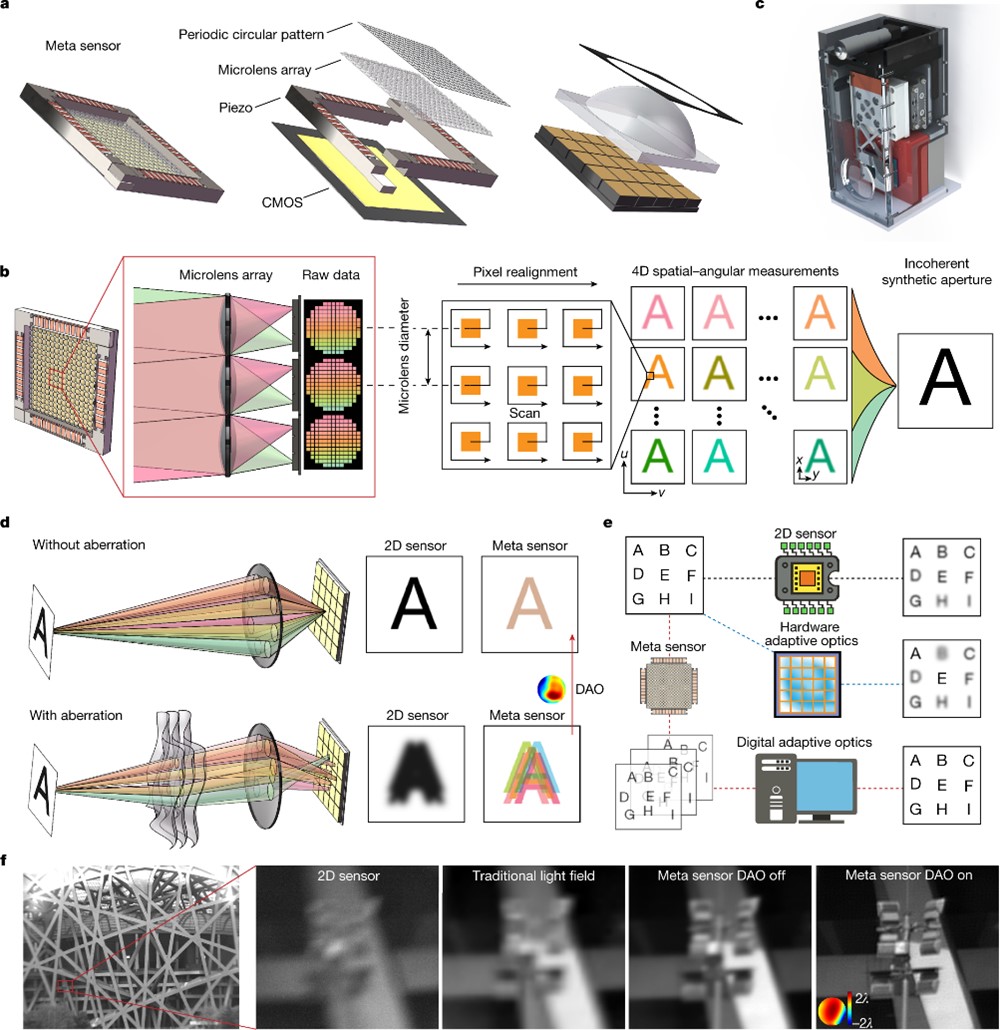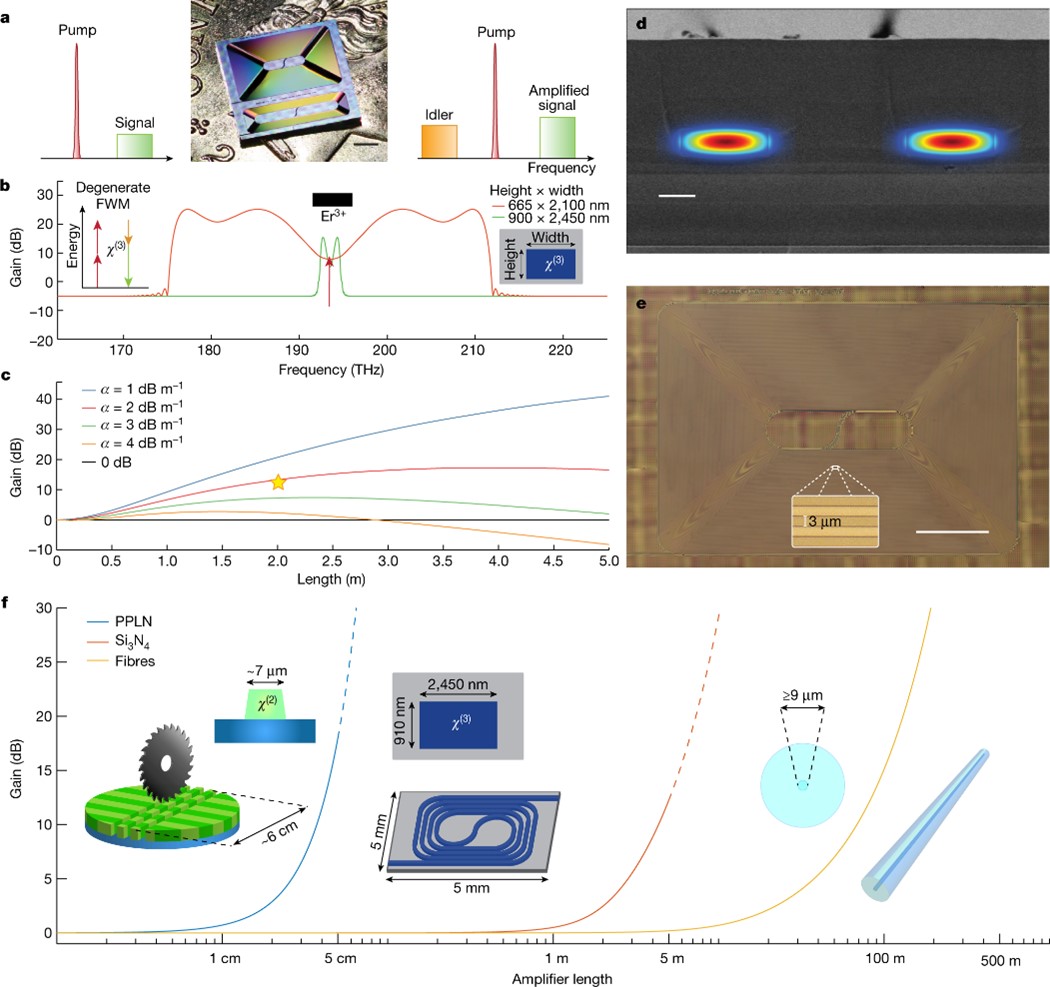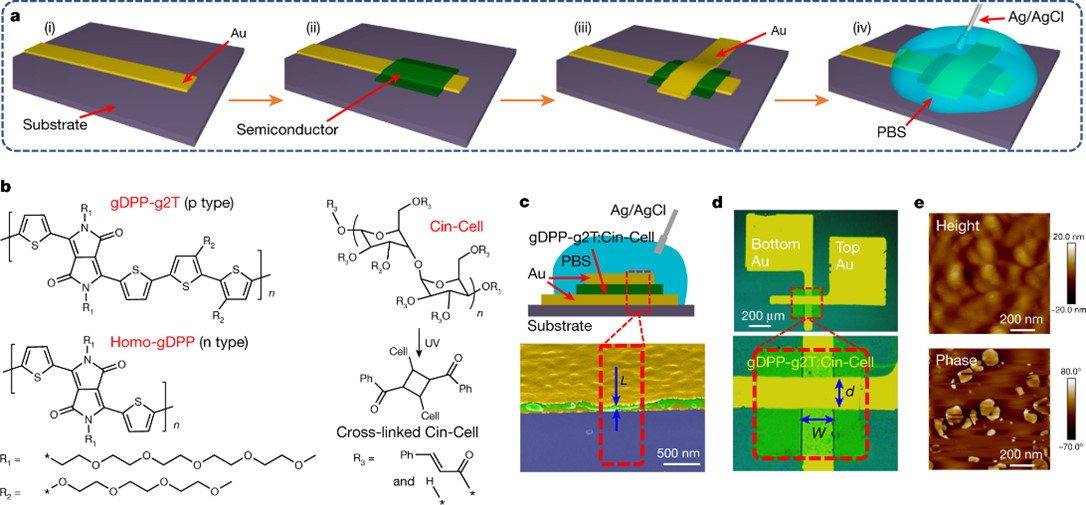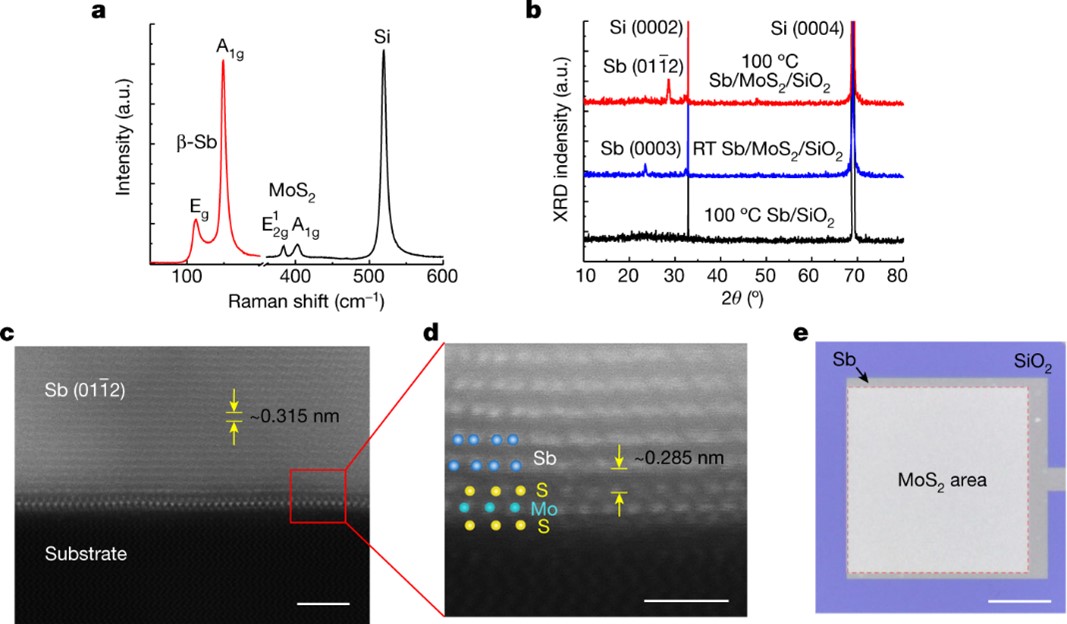热点文献带您关注半导体领域的最新进展——图书馆前沿文献专题推荐服务(77)
2023-04-28

在上一期热点文献推荐中,我们为您推荐了Transformer的最新发展前沿,包括半密集特征匹配Transformer及其在多视图几何中的应用,基于Transformer的任务感知弱监督目标定位,用于精确场景文本识别的图像-字符-单词Transformer,使用多模态Transformer生成情感视觉字幕,推送给相关领域的科研人员。
本期我们为您选取了4篇文献,介绍半导体领域的最新发展前沿,包括用于像差校正3D摄影的集成成像传感器,光子集成的连续行波光参量放大器,用于互补电路的垂直有机电化学晶体管,接近二维半导体接触的量子极限,推送给相关领域的科研人员。
An integrated imaging sensor for aberration-corrected 3D photography
Wu, Jiamin, etc.
NATURE, 2022, 612(7938): 62–71
Planar digital image sensors facilitate broad applications in a wide range of areas, and the number of pixels has scaled up rapidly in recent years. However, the practical performance of imaging systems is fundamentally limited by spatially nonuniform optical aberrations originating from imperfect lenses or environmental disturbances. Here we propose an integrated scanning light-field imaging sensor, termed a meta-imaging sensor, to achieve high-speed aberration-corrected three-dimensional photography for universal applications without additional hardware modifications. Instead of directly detecting a two-dimensional intensity projection, the meta-imaging sensor captures extra-fine four-dimensional light-field distributions through a vibrating coded microlens array, enabling flexible and precise synthesis of complex-field-modulated images in post-processing. Using the sensor, we achieve high-performance photography up to a gigapixel with a single spherical lens without a data prior, leading to orders-of-magnitude reductions in system capacity and costs for optical imaging. Even in the presence of dynamic atmosphere turbulence, the meta-imaging sensor enables multisite aberration correction across 1,000 arcseconds on an 80-centimetre ground-based telescope without reducing the acquisition speed, paving the way for high-resolution synoptic sky surveys. Moreover, high-density accurate depth maps can be retrieved simultaneously, facilitating diverse applications from autonomous driving to industrial inspections.
阅读原文:https://www.nature.com/articles/s41586-022-05306-8

Principle of the integrated meta-imaging sensor
A photonic integrated continuous-travelling-wave parametric amplifier
Riemensberger, Johann, etc.
NATURE, 2022, 612(7938): 56–61
The ability to amplify optical signals is of pivotal importance across science and technology typically using rare-earth-doped fibres or gain media based on III-V semiconductors. A different physical process to amplify optical signals is to use the Kerr nonlinearity of optical fibres through parametric interactions. Pioneering work demonstrated continuous-wave net-gain travelling-wave parametric amplification in fibres, enabling, for example, phase-sensitive (that is, noiseless) amplification, link span increase, signal regeneration and nonlinear phase noise mitigation. Despite great progress, all photonic integrated circuit-based demonstrations of net parametric gain have necessitated pulsed lasers, limiting their practical use. Until now, only bulk micromachined periodically poled lithium niobate (PPLN) waveguide chips have achieved continuous-wave gain, yet their integration with silicon-wafer-based photonic circuits has not been shown. Here we demonstrate a photonic-integrated-circuit-based travelling-wave optical parametric amplifier with net signal gain in the continuous-wave regime. Using ultralow-loss, dispersion-engineered, metre-long, Si3N4 photonic integrated circuits on a silicon chip of dimensions 5 x 5 mm2, we achieve a continuous parametric gain of 12 dB that exceeds both the on-chip optical propagation loss and fibre-chip-fibre coupling losses in the telecommunication C band. Our work demonstrates the potential of photonic-integrated-circuit-based parametric amplifiers that have lithographically controlled gain spectrum, compact footprint, resilience to optical feedback and quantum-limited performance, and can operate in the wavelength ranges from visible to mid-infrared and outside conventional rare-earth amplification bands.
阅读原文:https://www.nature.com/articles/s41586-022-05329-1

Principle of a photonic-integrated-circuit-based continuous-travelling-wave optical parametric amplifier
Vertical organic electrochemical transistors for complementary circuits
Huang, Wei, etc.
NATURE, 2023, 613(7944): 496–502
Organic electrochemical transistors (OECTs) and OECT-based circuitry offer great potential in bioelectronics, wearable electronics and artificial neuromorphic electronics because of their exceptionally low driving voltages (< 1 V), low power consumption (< 1 mu W), high transconductances (> 10 mS) and biocompatibility. However, the successful realization of critical complementary logic OECTs is currently limited by temporal and/or operational instability, slow redox processes and/or switching, incompatibility with high-density monolithic integration and inferior n-type OECT performance. Here we demonstrate p- and n-type vertical OECTs with balanced and ultra-high performance by blending redox-active semiconducting polymers with a redox-inactive photocurable and/or photopatternable polymer to form an ion-permeable semiconducting channel, implemented in a simple, scalable vertical architecture that has a dense, impermeable top contact. Footprint current densities exceeding 1 kA cm-2 at less than +/- 0.7 V, transconductances of 0.2-0.4 S, short transient times of less than 1 ms and ultra-stable switching (> 50,000 cycles) are achieved in, to our knowledge, the first vertically stacked complementary vertical OECT logic circuits. This architecture opens many possibilities for fundamental studies of organic semiconductor redox chemistry and physics in nanoscopically confined spaces, without macroscopic electrolyte contact, as well as wearable and implantable device applications.
阅读原文:https://www.nature.com/articles/s41586-022-05592-2

Fabrication scheme and vOECT materials used
Approaching the quantum limit in two-dimensional semiconductor contacts
Li, Weisheng, etc.
NATURE, 2023, 613(7943): 274–279
The development of next-generation electronics requires scaling of channel material thickness down to the two-dimensional limit while maintaining ultralow contact resistance. Transition-metal dichalcogenides can sustain transistor scaling to the end of roadmap, but despite a myriad of efforts, the device performance remains contact-limited. In particular, the contact resistance has not surpassed that of covalently bonded metal–semiconductor junctions owing to the intrinsic van der Waals gap, and the best contact technologies are facing stability issues. Here we push the electrical contact of monolayer molybdenum disulfide close to the quantum limit by hybridization of energy bands with semi-metallic antimony (011¯2) through strong van der Waals interactions. The contacts exhibit a low contact resistance of 42 ohm micrometres and excellent stability at 125 degrees Celsius. Owing to improved contacts, short-channel molybdenum disulfide transistors show current saturation under one-volt drain bias with an on-state current of 1.23 milliamperes per micrometre, an on/off ratio over 108 and an intrinsic delay of 74 femtoseconds. These performances outperformed equivalent silicon complementary metal–oxide–semiconductor technologies and satisfied the 2028 roadmap target. We further fabricate large-area device arrays and demonstrate low variability in contact resistance, threshold voltage, subthreshold swing, on/off ratio, on-state current and transconductance. The excellent electrical performance, stability and variability make antimony (011¯2) a promising contact technology for transition-metal-dichalcogenide-based electronics beyond silicon.
阅读原文:https://www.nature.com/articles/s41586-022-05431-4

Characterization of the Sb (011¯2)–MoS2 contact
往期精彩推荐
热点论文解读AI应用领域 ——图书馆前沿文献专题推荐服务(3)
热点论文带您探究5G和未来通信——图书馆前沿文献专题推荐服务 (4)
前沿文献带您解读自然语言处理技术 ——图书馆前沿文献专题推荐服务(5)
热点论文带您探究5G和未来通信材料技术领域 ——图书馆前沿文献专题推荐服务(6)
热点文献带您关注AI情感分类技术 ——图书馆前沿文献专题推荐服务(7)
热点论文带您探究6G的无限可能——图书馆前沿文献专题推荐服务(8)
热点文献带您关注AI文本摘要自动生成 ——图书馆前沿文献专题推荐服务(9)
热点论文:5G/6G引领社会新进步——图书馆前沿文献专题推荐服务(10)
热点文献带您关注AI机器翻译 ——图书馆前沿文献专题推荐服务(11)
热点论文与您探讨5G/6G网络技术新进展——图书馆前沿文献专题推荐服务(12)
热点文献带您关注AI计算机视觉 ——图书馆前沿文献专题推荐服务(13)
热点论文与带您领略5G/6G的硬科技与新思路 ——图书馆前沿文献专题推荐服务(14)
热点文献带您关注AI计算机视觉 ——图书馆前沿文献专题推荐服务(15)
热点论文带您领略5G/6G的最新技术动向 ——图书馆前沿文献专题推荐服务(18)
热点文献带您关注图神经网络——图书馆前沿文献专题推荐服务(19)
热点论文与带您领略5G/6G材料技术的最新发展——图书馆前沿文献专题推荐服务(20)
热点文献带您关注模式识别——图书馆前沿文献专题推荐服务(21)
热点论文与带您领略6G网络技术的最新发展趋势 ——图书馆前沿文献专题推荐服务(22)
热点文献带您关注机器学习与量子物理 ——图书馆前沿文献专题推荐服务(23)
热点论文与带您领略5G/6G通信器件材料的最新进展 ——图书馆前沿文献专题推荐服务(24)
热点文献带您关注AI自动驾驶——图书馆前沿文献专题推荐服务(25)
热点论文与带您领略5G/6G网络安全和技术的最新进展——图书馆前沿文献专题推荐服务(26)
热点文献带您关注AI神经网络与忆阻器——图书馆前沿文献专题推荐服务(27)
热点论文与带您领略5G/6G电子器件和太赫兹方面的最新进展——图书馆前沿文献专题推荐服务(28)
热点文献带您关注AI与机器人——图书馆前沿文献专题推荐服务(29)
热点论文与带您领略5G/6G热点技术的最新进展——图书馆前沿文献专题推荐服务(30)
热点文献带您关注AI与触觉传感技术——图书馆前沿文献专题推荐服务(31)
热点论文与带您领略5G/6G热点技术的最新进展——图书馆前沿文献专题推荐服务(32)
热点文献带您关注AI深度学习与计算机视觉——图书馆前沿文献专题推荐服务(33)
热点论文与带您领略未来通信的热点技术及最新进展——图书馆前沿文献专题推荐服务(34)
热点文献带您关注AI强化学习——图书馆前沿文献专题推荐服务(35)
热点论文与带您领略5G/6G基础研究的最新进展——图书馆前沿文献专题推荐服务(36)
热点文献带您关注AI与边缘计算——图书馆前沿文献专题推荐服务(37)
热点论文与带您领略5G/6G领域热点研究的最新进展——图书馆前沿文献专题推荐服务(38)
热点文献带您关注AI技术的最新进展——图书馆前沿文献专题推荐服务(39)
热点论文与带您领略5G相关领域研究的最新进展——图书馆前沿文献专题推荐服务(40)
热点文献带您关注AI视觉跟踪——图书馆前沿文献专题推荐服务(41)
热点论文带您领略未来通信在海空领域研究的最新进展——图书馆前沿文献专题推荐服务(42)
热点文献带您关注AI与医学研究——图书馆前沿文献专题推荐服务(43)
热点论文带您领略未来通信在材料领域研究的最新进展——图书馆前沿文献专题推荐服务(44)
热点文献带您关注AI与医学图像——图书馆前沿文献专题推荐服务(45)
热点论文带您领略未来通信在光电材料及信息编码领域的最新进展——图书馆前沿文献专题推荐服务(46)
热点文献带您关注AI与生物学——图书馆前沿文献专题推荐服务(47)
热点论文带您领略未来通信在新材料技术领域的最新进展——图书馆前沿文献专题推荐服务(48)
热点文献带您关注AI与人脸识别——图书馆前沿文献专题推荐服务(49)
热点论文带您领略光电半导体领域的最新进展——图书馆前沿文献专题推荐服务(50)
热点文献带您关注AI在集成电路领域的最新进展——图书馆前沿文献专题推荐服务(51)
热点论文带您领略半导体领域的最新进展——图书馆前沿文献专题推荐服务(52)
热点文献带您关注AI在光神经网络领域的最新进展——图书馆前沿文献专题推荐服务(53)
热点论文带您领略未来通信在新材料技术领域的最新进展——图书馆前沿文献专题推荐服务(54)
热点文献带您关注AI深度神经网络的最新进展——图书馆前沿文献专题推荐服务(55)
热点论文带您领略新材料半导体领域的最新进展——图书馆前沿文献专题推荐服务(56)
热点文献带您关注AI视频动作识别的最新进展——图书馆前沿文献专题推荐服务(57)
热点论文带您领略未来通信热点技术的最新进展——图书馆前沿文献专题推荐服务(58)
热点文献带您关注AI深度学习的最新进展——图书馆前沿文献专题推荐服务(59)
热点论文带您领略未来通信研究热点的最新进展——图书馆前沿文献专题推荐服务(60)
热点文献带您关注AI领域的最新进展——图书馆前沿文献专题推荐服务(61)
热点论文带您探索智能化以及超表面在未来通信中的应用——图书馆前沿文献专题推荐服务(62)
热点文献带您关注AI领域的最新进展——图书馆前沿文献专题推荐服务(63)
热点论文带您领略半导体领域的最新进展——图书馆前沿文献专题推荐服务(64)
热点文献带您关注AI领域的最新进展——图书馆前沿文献专题推荐服务(65)
热点论文带您探索新型网络架构以及超表面在未来通信中的应用——图书馆前沿文献专题推荐服务(66)
热点文献带您关注AI深度强化学习的最新进展——图书馆前沿文献专题推荐服务(67)
热点论文带您探索新型网络架构以及超材料在未来通信中的应用——图书馆前沿文献专题推荐服务(68)
热点文献带您关注AI图神经网络的最新进展——图书馆前沿文献专题推荐服务(69)
热点论文带您探索未来网络中使用的新材料以及相关技术 ——图书馆前沿文献专题推荐服务(70)
热点文献带您关注AI的最新进展——图书馆前沿文献专题推荐服务(71)
热点文献带您关注电子皮肤的最新进展——图书馆前沿文献专题推荐服务(72)
热点文献带您关注存算一体技术的最新进展——图书馆前沿文献专题推荐服务(73)
热点文献带您关注惯性测量单元的最新进展——图书馆前沿文献专题推荐服务(74)
热点文献带您关注低轨卫星通信技术的最新进展——图书馆前沿文献专题推荐服务(75)
热点文献带您关注AI Transformer的最新进展——图书馆前沿文献专题推荐服务(76)